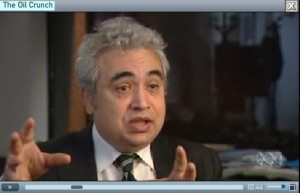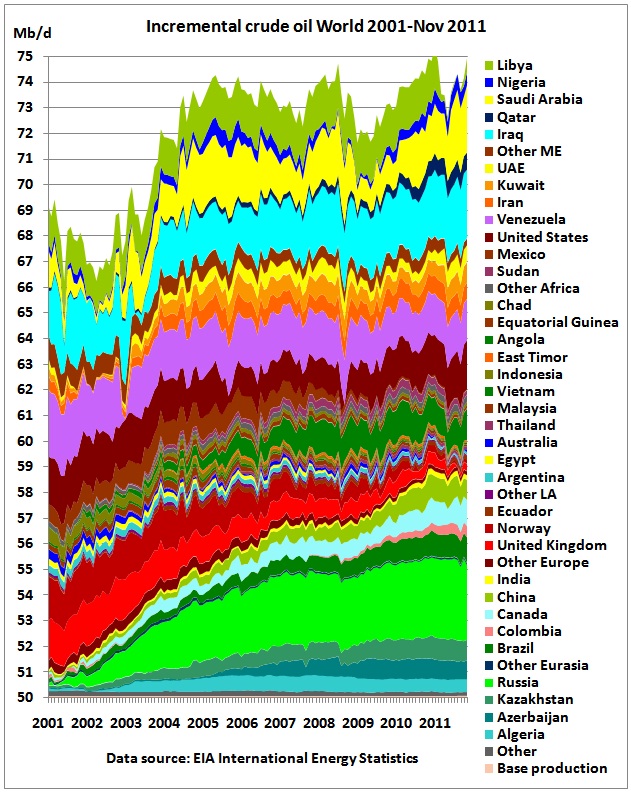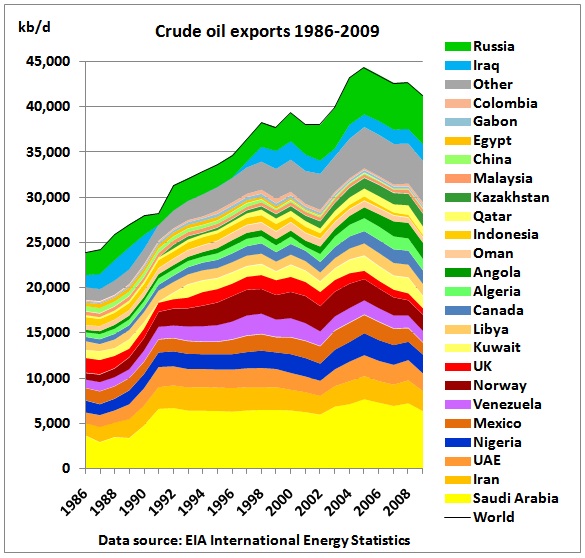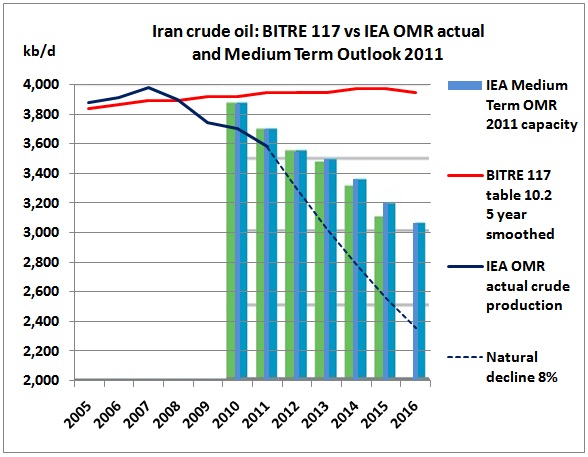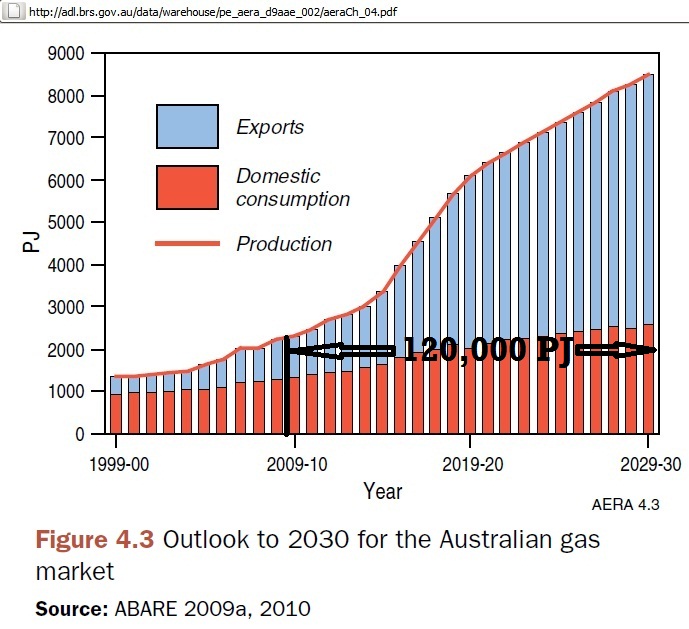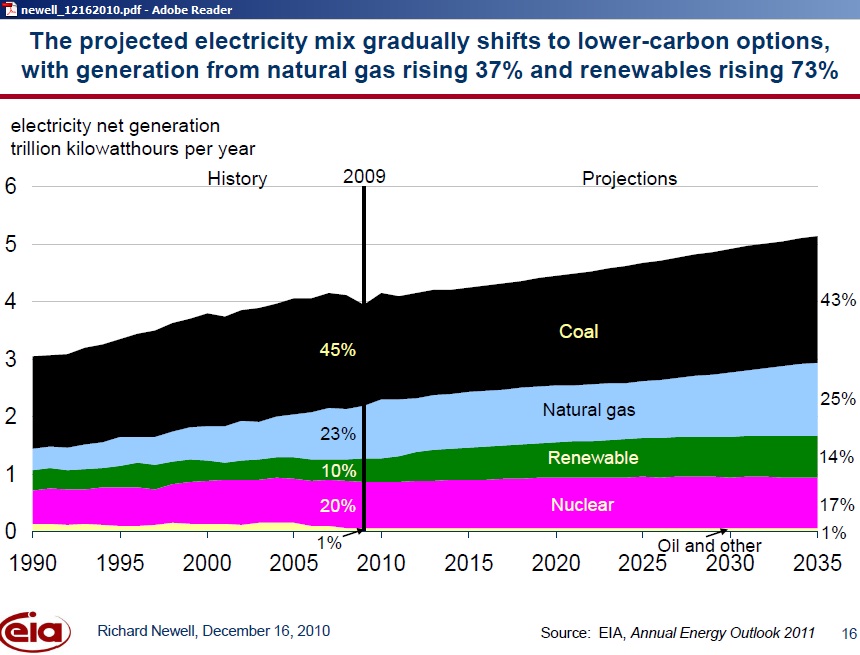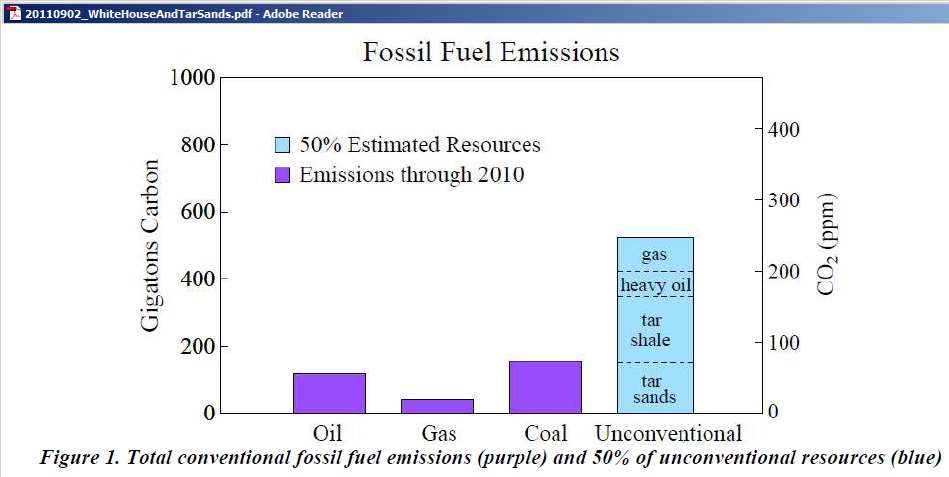This article is on Alan Kohler ‘s piece “The death of peak oil”
http://www.abc.net.au/news/2012-02-29/kohler-oil-reserves-shift-global-markets/3859118
Contents:
(1) Too many peaks to handle
(2) US shale oil production and projections
(3) Tough structural transformations
(4) Reserves versus resources
(5) Vast gas is squandered
(6) US self-sufficiency in oil shale boom?
(7) No intention to replace coal by gas
(8) Contribution of un-conventional oil and gas to CO2 concentration
(9) Saudi Arabia likes the shale oil story
(10) Never running out of peak oil debunkers
Summary
Alan Kohler, who is known for his excellent financial graphs on the ABC TV 7 pm News 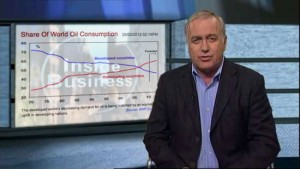 came out with an opinion piece on peak oil which does not display the level of research expected from him. Almost no statement in his article can be supported by statistical evidence. No numbers are shown to prove that shale oil can compensate for oil decline in maturing oil fields around the world. What’s worse, the fight over oil in and between Middle East and North Africa (MENA) countries due to peaking in key countries is completely forgotten. The EIA estimates that despite increasing unconventional oil production the dependency on OPEC oil will not be reduced. Reserves and resources are mixed up and those vast gas reserves are neither used to replace coal nor oil (as transport fuel). The CO2 from an assumed unconventional oil and gas boom will cook us alive.
came out with an opinion piece on peak oil which does not display the level of research expected from him. Almost no statement in his article can be supported by statistical evidence. No numbers are shown to prove that shale oil can compensate for oil decline in maturing oil fields around the world. What’s worse, the fight over oil in and between Middle East and North Africa (MENA) countries due to peaking in key countries is completely forgotten. The EIA estimates that despite increasing unconventional oil production the dependency on OPEC oil will not be reduced. Reserves and resources are mixed up and those vast gas reserves are neither used to replace coal nor oil (as transport fuel). The CO2 from an assumed unconventional oil and gas boom will cook us alive.
The problem with such articles is that they contribute to further delay the real transformation away from oil (and fossil fuels in general) which can only be done by massive rail projects and preserving oil where it will be needed most: in agricultural production and transport of food to the cities.
| Here is already the 1st victim of a series of peak oil death stories (of which Alan Kohler’s is the latest): Chevy Volt production haltedGeneral Motors sends workers home from Volt plant due to lack of demand.
http://smh.drive.com.au/motor-news/chevy-volt-production-halted-20120303-1u9b6.html No wonder. Why go electric if there is enough oil at last? |
Introduction
Alan Kohler: “Now we have the death of peak oil….…Forget declining oil, there is a new global oil rush…. the existence of vast reserves of oil and gas in shale formations, mainly in the United States, …… is producing a profound transformation of energy markets.”
Alan tries the impossible: to debunk peak oil on 2 pages without number crunching. Just calculating the peaking in giant oil fields requires a master thesis as was done by F. Robelius at the Uppsala University in Sweden
http://www.peakoil.net/GiantOilFields.html
And while we watch both peak oil and global warming on our TV screens getting worse year by year, the denial of the government, the media and the corporate sector seems to increase:
 Meta function depicting peak oil denial path
Meta function depicting peak oil denial path
(1) Too many peaks to handle
So death of which oil peak exactly? There are many different peaks:
Globally:
(1.1) Conventional crude oil peak.
IEA chief economist Fatih Birol:
“When we look at the oil markets the news is not very bright. We think that the crude oil production has already peaked in 2006” http://www.abc.net.au/catalyst/stories/3201781.htm
(1.2) Peak of all crude oil including non-conventional oil
(1.3) Peak of all crude oil plus condensate (focus of this website)
#2 and #3 are very difficult to distinguish as crude oil statistics sometimes include part or all of the condensates and sometimes not. Some condensate is included in natural gas liquids.
All crude oil plus condensate (EIA statistics) started to peak in 2005.
This peaking is a process (not an easily identifiable event like 9/11) which is still ongoing. It is called a bumpy production plateau. This graph shows that Russia recued the world from a deep oil crisis:
(1.4) Peak of all crude oil, condensate and natural gas liquids
(1.5) Peaking of crude oil exports (happened in 2005)
In the Middle East
(1.6) Peaking in many countries, in particular in MENA countries with dramatic impacts on social cohesion and geo-political stability. This can be seen every day on TV.
Oil pipeline hit in Homs, Syria in February 2012. Syrian oil production peaked in 1994. Growing oil consumption leads to a reduction in net exports and budget problems. The social unrest in Syria is strangely mixed with a proxy war between the West and Iran
The US can produce as much shale oil as it likes, this will not stop peak oil in Iran.
Ironically, sanctions imposed by the West will speed up this process.
We can be sure that the Iranian government will always create problems in the Middle East to keep oil prices high.
Note that the estimate of the dumped BITRE 117 report is high above the IEA Medium Term Outlook 2011, something the Energy White Paper team should have picked up.
Other countries where peak oil has happened: Egypt (very critical because of Suez canal and Sumed pipeline), Sudan and Yemen. Another candidate is Algeria. And Nigeria is struggling to reduce fuel subsidies.
(2) US shale oil production and projections
So in which of the 6 peaking processes do we include shale oil? It goes into (2). In order to debunk the peaking of crude oil production, one would have to do quite a bit of number crunching: show that annual shale oil production can compensate for crude oil decline elsewhere.
What is the magnitude of this miracle shale oil so far? This is the example of North Dakota, part of the Midwest (PADD2) 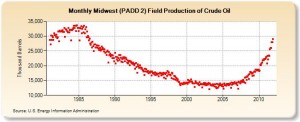 http://www.eia.gov/dnav/pet/hist_chart/MCRFPP21M.jpg
http://www.eia.gov/dnav/pet/hist_chart/MCRFPP21M.jpg
That looks impressive. And this is the production by State, North Dakota is the shale oil area:
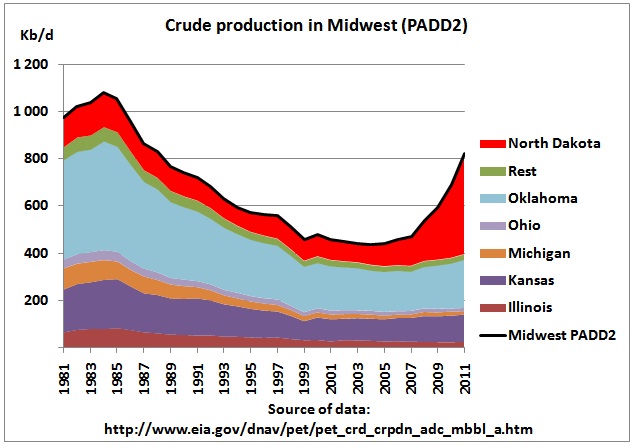 http://www.eia.gov/dnav/pet/pet_crd_crpdn_adc_mbbl_a.htm
http://www.eia.gov/dnav/pet/pet_crd_crpdn_adc_mbbl_a.htm
But the production levels of 1984 have not been reached yet. How will that continue?
 https://www.dmr.nd.gov/oilgas/presentations/ActivityUpdateRotaryClubBismarck2011-03-09.pdf
https://www.dmr.nd.gov/oilgas/presentations/ActivityUpdateRotaryClubBismarck2011-03-09.pdf
Oh yes, it peaks. And look what price increase you need to get a mere 100 kb/d extra. And the individual well peaks look shocking (from the same report):
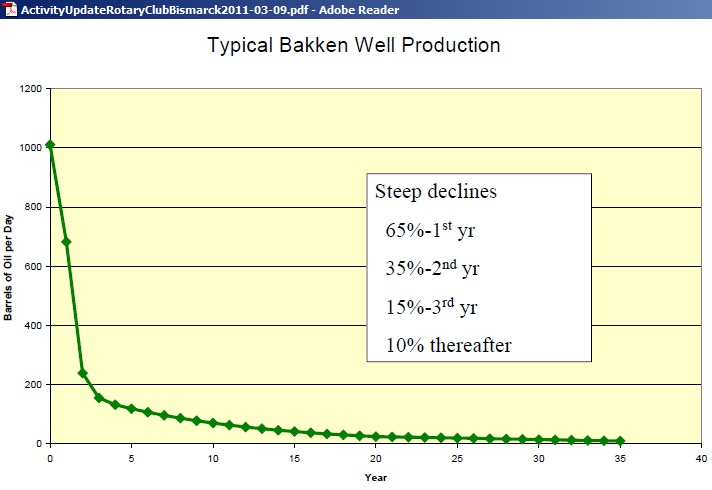 This means it will be a constant battle to replace lost production with new wells.
This means it will be a constant battle to replace lost production with new wells.
 ftp://ftp.eia.doe.gov/natgas/usshaleplays.pdf
ftp://ftp.eia.doe.gov/natgas/usshaleplays.pdf
Wells produce only a small amount of oil, just 550 Kb over their lifetime.
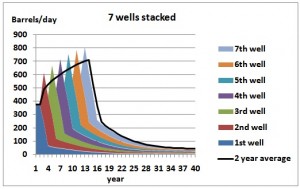 Let’s do a very simple, theoretical model how a series of wells would be produced. The first 2 years are kept at a 2 year average to avoid those 1st year spikes. Adjustments are made so that cumulative production is 550 kb.
Let’s do a very simple, theoretical model how a series of wells would be produced. The first 2 years are kept at a 2 year average to avoid those 1st year spikes. Adjustments are made so that cumulative production is 550 kb.
We can see that a series of wells creates its own peak in the year that no more wells can be added. The decline after the peak is steep.
In Eagle Ford an average well produces much less, only 300 Kb. 5 wells are drilled per square mile. The result looks like this (note the authors of this paper consider this to be a small footprint
 https://www.dmr.nd.gov/oilgas/presentations/ActivityUpdateRotaryClubBismarck2011-03-09.pdf
https://www.dmr.nd.gov/oilgas/presentations/ActivityUpdateRotaryClubBismarck2011-03-09.pdf
And we need to look at the impact on the whole US picture:
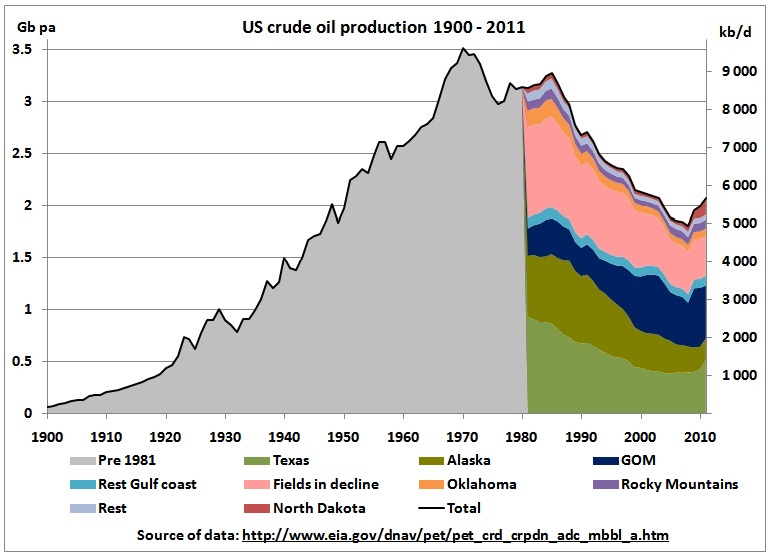 http://www.eia.gov/dnav/pet/pet_crd_crpdn_adc_mbbl_a.htm
http://www.eia.gov/dnav/pet/pet_crd_crpdn_adc_mbbl_a.htm
That’s a small uptick compared to the 1970 peak. The US would have a long way to go back to that previous level.
And what is the outlook for the next 25 years? The graph below is from the US department of Energy (EIA), they are certainly fans of unconventional oil (Annual Energy Outlook, 2012 Early Release, link below)
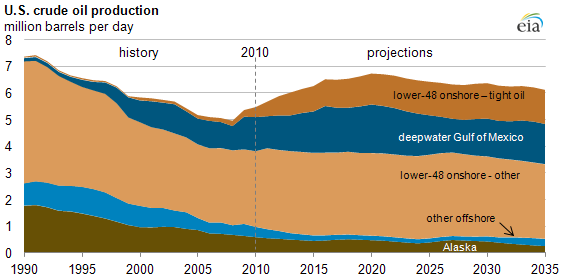 http://205.254.135.7/todayinenergy/images/2012.02.08/AEO2012Crude.png
http://205.254.135.7/todayinenergy/images/2012.02.08/AEO2012Crude.png
EIA projects that U.S. domestic crude oil production will increase from 5.5 million barrels per day in 2010 to 6.7 million barrels per day in 2020. Even with a projected decline after 2020, U.S. crude oil production projections remain above 6 million barrels per day through 2035.
The AEO2012 Early Release Reference case projects that onshore tight oil production will increase significantly, reaching 1.3 million barrels per day in 2030 and remaining above 1 million barrels per day for the remainder of the projection.
http://205.254.135.7/todayinenergy/detail.cfm?id=4910
There you are: 1.3 Mb/d in 2030. Hardly a “profound” transformation.
Now let’s graph the estimate out to 2035, to see how it compares to other high production points in the past (the EIA was too shy to show it in their graph):
(3) Tough structural transformations
More structural transformations you have to get your head around:
Alan Kohler: “We’ve already got the digital revolution…. “
Which is basically miniaturization. But you cannot miniaturize energy which is fundamentally different from consumables.
Alan Kohler: “…and the switch from consumption to savings after the GFC…..”
Really?
Alan Kohler: “….not to mention the rise of China and India…..”
Which of course makes the inpact peak oil much worse.
 Alan Kohler: “… For years we have assumed that fossil fuel reserves were running out, …”
Alan Kohler: “… For years we have assumed that fossil fuel reserves were running out, …”
Who is “we”? Not the Australian government.
24/2/2012
Australian Government kicks own goals in Senate peak oil debate (peaky leaks part 3)
Alan Kohler: ….and that it was only a matter of time before the oil price rose to such heights that energy-dependent economies would be crushed, starting with the United States.
Statistics show that petroleum consumption peaked between 2004 and 2007, around the period when crude oil started to peak. Despite an oil supply uptick, consumption went down. The oil prices are just too high.
(4) Reserves vs. resources
Alan Kohler: “… The US has an estimated 2 trillion barrels of shale oil reserves – about 70 per cent of the world’s total and eight times the oil reserves of Saudi Arabia.”
Where is that number from?
In a recent conference, the Director of the US Geological Survey presented a slide show “US Energy Outlook: Whatever happened to peak oil?” (she should have looked at the above US consumption graph)
http://bloomington.in.gov/media/media/application/pdf/11326.pdf
Her presentation included a link to this report:
Assessment of Undiscovered Oil Resources in the Devonian-Mississippian Bakken Formation, Williston Basin Province, Montana and North Dakota, 2008
April 2008
Using a geology-based assessment methodology, the U.S. Geological Survey estimated mean undiscovered volumes of 3.65 billion barrels of oil, 1.85 trillion cubic feet of associated/dissolved natural gas, and 148 million barrels of natural gas liquids in the Bakken Formation of the Williston Basin Province, Montana and North Dakota.
http://pubs.usgs.gov/fs/2008/3021/pdf/FS08-3021_508.pdf
So what is the total for the Lower 48 States?
 ftp://ftp.eia.doe.gov/natgas/usshaleplays.pdf
ftp://ftp.eia.doe.gov/natgas/usshaleplays.pdf
(Note: a new EIA resource report is due out in April 2012)
That’s 24 Gb technically recoverable oil. How much of that can be turned into economically recoverable reserves is another question. So how does that compare to other oil resources?
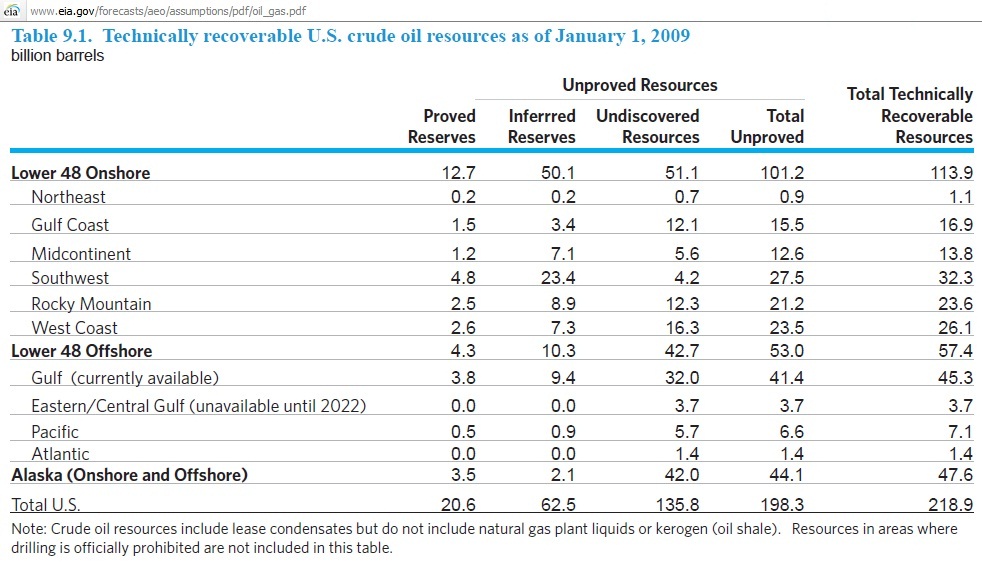 http://www.eia.gov/forecasts/aeo/assumptions/pdf/oil_gas.pdf
http://www.eia.gov/forecasts/aeo/assumptions/pdf/oil_gas.pdf
This illustrates that shale oil is just a bit more than 10% of the US resource base in the above table. And even if Saudi Arabia had only ASPO’s estimate of 144 Gb (in 2004) – 7*3 = 123 Gb that would be 5 times more than the US shale oil.
 http://www.energybulletin.net/node/2390
http://www.energybulletin.net/node/2390
My comment: Shale oil should be used in future to drive agricultural machinery, but not hundreds of millions of cars. In any case, shale oil is definitely not a global turn-around that ‘kills’ peak oil.
(5) Vast gas is squandered
Alan Kohler: “The gas reserves, in the US, Australia and elsewhere, are vast.”
Australia:
According to the Australian Energy Resource Assessment (March 2010 – still the latest as this web site is referred to in the November 2011 Energy White Paper)
https://www.ga.gov.au/products/servlet/controller?event=GEOCAT_DETAILS&catno=70142
Economically demonstrated gas reserves are 122,100 PJ
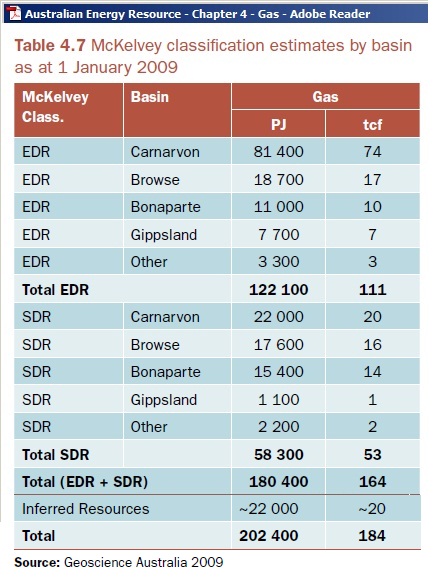 With current plans and projects underway these will be consumed domestically and exported in the short time span of just 20 years. Well, that is not vast. And what comes after 2030?
With current plans and projects underway these will be consumed domestically and exported in the short time span of just 20 years. Well, that is not vast. And what comes after 2030?
Read here:
11/10/2011 Australia’s natural gas squandered in LNG exports
http://crudeoilpeak.info/australias-natural-gas-squandered-in-lng-exports
13/10/2011 NSW gas as transport fuel. Where are the plans?
http://crudeoilpeak.info/nsw-gas-as-transport-fuel-where-are-the-plans
(6) US self-sufficiency in oil shale boom?
Alan Kohler: “The drive for self-sufficiency in oil and gas is very powerful indeed, …
If the United States could become self-sufficient in energy, its current account deficit would disappear and the US dollar would start rising again.
In fact, shale energy could be responsible for the resurgence of the United States as an economic superpower, with cheap local energy underpinning the second coming of its manufacturing industry as well as helping to balance its twin deficits – current account and federal budget.”
Let’s check the EIA estimates to see how powerful that drive will be. The “Annual Energy Outlook 2011” estimates how that self-sufficiency will change over time:
 http://www.eia.gov/neic/speeches/newell_12162010.pdf
http://www.eia.gov/neic/speeches/newell_12162010.pdf
Note that the EIA is a government department in the US, the very country where the shale oil boom is taking place. Net petroleum imports are reduced from 52% to 42% in a period of 25 years. And the physical imports don’t change much at all. That’s not powerful. And the statistical %age reduction has been achieved by adding biofuels to the mix. There is no way the US will become self-sufficient in oil. And let’s have a look at the greater fuel efficiencies in the same slide show:
Ooops, total fuel consumption (and that is what really matters) goes up, not down, whether this is caused by growing population, assumed economic growth or a combination thereof.
Alan Kohler: The importance of this for the world is hard to exaggerate. The distribution of energy on the planet is shifting: the stranglehold that Middle Eastern dictatorships have over the world’s energy supply is loosening…
This graph shows that nothing will change in relation to dependence on OPEC oil. The percentage is practically the same.
(7) No intention to replace coal by gas
Alan Kohler: There will be a rapid substitution of coal by cleaner gas….
Let us see in which sectors of the economy this gas is used:
The gas use for central electric power does not change much at all. Nothing set aside for gas as transport fuel.
This is not a rapid substitution of coal.
Alan Kohler: It means renewable energy and nuclear will become less and less economic as the supply of gas increases, whether it’s from coal seams or shale.
Not in the US, and not according to the estimates of the EIA on the above graph.
And how about Australia? In the chapter on coal of the above mentioned Australian Resource Assessment the list of coal projects goes over 5 pages:
• Australia’s coal production is projected to increase at an average annual rate of 1.8 per cent to about 13 875 PJ in 2029–30.
https://www.ga.gov.au/servlet/BigObjFileManager?bigobjid=GA17413
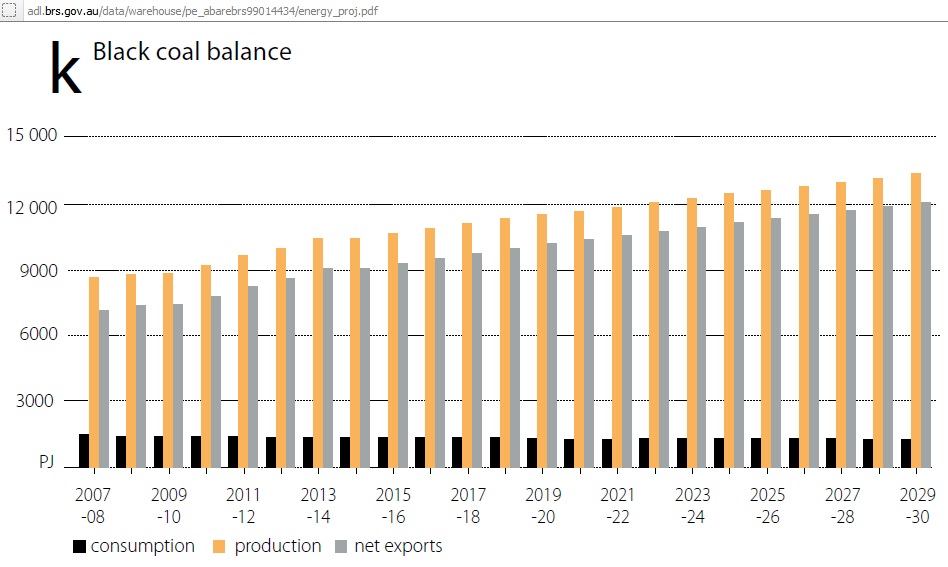 http://adl.brs.gov.au/data/warehouse/pe_abarebrs99014434/energy_proj.pdf
http://adl.brs.gov.au/data/warehouse/pe_abarebrs99014434/energy_proj.pdf
No indication here that coal exports will be reduced and replaced by natural gas exports. To the contrary, both coal and gas exports are being increased.
One of our keen supporters of coal was pop star and former so-called Environment Minister Peter Garrett who approved the Wiggins coal terminal (which is now under construction)
 http://www.deedi.qld.gov.au/cg/wiggins-island-coal-terminal.html
http://www.deedi.qld.gov.au/cg/wiggins-island-coal-terminal.html
50 year horizon according to the EIS documents!!! See next chapter on the future of coal.
(8) Contribution of unconventional oil and gas to CO2 concentration
Alan Kohler: “Gas is less carbon-intensive than coal, but it still produces greenhouse gases, so it may be that the policy response to reduce global warming will actually have to increase if the world moves too far towards gas and away from renewables and nuclear.”
So what would that policy response be?
NASA climatologist James Hansen set the timeline in a seminar at Sydney Uni
8/3/2010
“Australia doesn’t agree now that they got to stop their coal, but they are going to agree. I can guarantee you that within a decade or so because the climate change will become so strongly apparent that’s going to become imperative”
http://www.usyd.edu.au/sydney_ideas/lectures/2010/professor_james_hansen.shtml
http://www.columbia.edu/~jeh1/mailings/2011/20110902_WhiteHouseAndTarSands.pdf
The graph shows that burning 50% of unconventional oil and gas would increase CO2 concentrations by 250 ppm. We’ll be cooked alive.
What we experience already now:
Oklahoma-Texas-Northern Mexico in 2011 and the Moscow region in 2010 provide examples of summer heat anomalies that exceeded 3σ relative to the 1951-1980 climatology. In the 1951-1980 period of climatology the area with temperature anomaly exceeding +3σ was only a few tenths of one percent. However, the area covered by such extreme anomalies has increased with global warming. +3σ anomalies covered 7% of the area with observations in Jun-Jul-Aug 2009, 13% in 2010, and 9% in 2011 (Hansen et al., 2012). Increased occurrence of such extreme anomalies as a result of global warming, by more than a factor of 10, implies that we can attribute such recent extreme anomalies, including that in Texas and Oklahoma, to global warming.
http://www.columbia.edu/~jeh1/mailings/2012/20120119_Temperature.pdf
(9) Saudi Arabia likes the shale oil story
Guess who likes these peak oil death stories? Saudi Arabia. Because they can now hide the fact that they will never be able to increase oil production. They don’t have the reserves
New oil reserves pose threat to OPEC dominance
“The abundance of resources and the more ‘balanced’ geographical distribution of unconventionals have reduced the much-hyped concerns over ‘energy security’ which once served as the undercurrent driving energy policies and dominated the global energy debate,” Khalid Al-Falih, the Aramco CEO, said last week at the Energy Dialogue organized by the King Abdullah Petroleum Studies and Research Center.
As a result, Saudi Aramco had no plans to increase its oil production capacity to 15 million bpd. “Saudi Aramco has more spare capacity than the Kingdom is obligated to or has committed to,” he told reporters. “So it wouldn’t make sense.” In October too, Al-Falih had said that in view of altered circumstances, there was no need and reason for Aramco to significantly increase its oil production capacity in the mid-term.
OPEC expects global output of this non-conventional oil to rise 3.4 million bpd by 2015, still dominated by oil sands, to 5.8 million bpd by 2025 and to 8.4 million bpd by 2035 when tight oil would be playing a much bigger role.
http://arabnews.com/economy/article539035.ece
The following slide was presented by Nansen G. Saleri, head of reservoir management in Saudi Aramco, at the CERA week 2004 conference.
 http://www.ihs.com/products/cera/index.aspx
http://www.ihs.com/products/cera/index.aspx
MSC=maximum sustainable capacity MNF = Manifa oil field, note it was planned for 2011
However, in June 2011 we were informed:
Saudi Aramco, the world’s largest oil exporter, is accelerating by a decade plans to boost production capacity at its Manifa oil field development to pump the heavy crude needed to feed three planned refineries.
Additional production from Manifa will help maintain Aramco’s maximum sustainable oil production capacity at 12 million barrels a day
At Manifa, the world’s fifth-largest oil field, Aramco is building 41 kilometers (25 miles) of causeway to connect 27 man- made islands built to support drilling rigs to crude and gas processing facilities on the mainland. The field is set to have the capacity to pump Arabian Heavy crude at a rate of 500,000 barrels a day by 2013 before ramping up to full capacity a year later, the company said.
Read also:
2/3/2011
WikiLeaks cable from Riyadh implied Saudis could pump only 9.8 mb/d in 2011
http://crudeoilpeak.info/wikileaks-cable-from-riyadh-implied-saudis-could-pump-only-9-8-mbd-in-2011
(10) Never running out of peak oil debunkers
Alan Kohler: One thing is for sure: the world isn’t running out of oil and gas any more….
Peaking oil production isn’t running out of oil (yes, it’s about running out of cheap oil). But one thing is for sure: we are never going to run out of people trying to debunk peak oil – and shooting themselves in the foot.
Conclusion:
Come on, Alan, you can do a lot better than this. We all love your graphs in the ABC TV 7 pm News, but this opinion piece did not feature your usually high standard of research. Maybe it was written by someone else? Or was this just about advising us to invest in shale oil companies, wrecking the world’s climate in the process?
